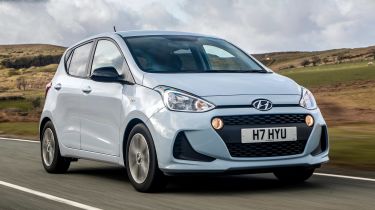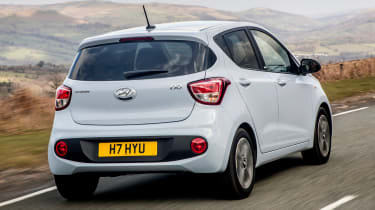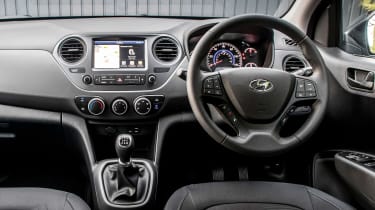New Hyundai i10 Play 2019 review
The new Hyundai i10 Play comes with plenty of extra kit, but does that make the i10 a more desirable option in the city car class?
The Hyundai i10 is getting a little long in the tooth now: the engine needs to be worked hard out on the open road and the interior design is a little dated. However, a smooth ride and light steering means that as an unpretentious city runabout, there’s much to like. The new Play trim offers great value, too, usefully undercutting rivals like the VW up! on price. That it offers several features – such as built-in sat nav – that are rare in this class, ensures there’s still life in the i10 yet.
This is the Hyundai i10 Play: a recent addition to the city car’s range that aims to breathe new life into the brand’s Volkswagen up! and Toyota Aygo challenger. Having been around since 2013, does the improved kit list do enough to make it worth considering?
Priced from £11,195, the Play costs roughly the same as the existing SE, but it’s treated to a heap of extra kit to make it a more desirable option. Two features, one cosmetic, one practical, are lifted from the top-spec Premium SE trim, to add to the Play’s appeal. On the outside that means the Play rides on a set of 15-inch alloy wheels, while inside it benefits from a seven-inch infotainment system.
More reviews
Car group tests
- Hyundai i10 vs Kia Picanto: 2022 twin test review
- Toyota Aygo X vs Hyundai i10 vs Fiat 500: 2022 group test review
- Hyundai i10 vs Toyota Aygo vs Kia Picanto
In-depth reviews
Road tests
- New Hyundai i10 N Line 2024 review: souped-up city car proves size doesn’t matter
- New Hyundai i10 N Line 2020 review
- New Hyundai i10 2020 review
Used car tests
Not only does the touchscreen offer Apple CarPlay and Android Auto compatibility, but also built-in satellite navigation. If you want that elsewhere in a city car, you’d need to spend at least £13,150 on a mid-range Kia Picanto, or over £15,000 on a high-end Fiat 500. It’s a good system, too; not quite as responsive to touches as the tech you’ll find in pricier cars, but the layout it functional and the graphics are clear.
The new special edition model adds a few more extras unique to the i10. The Play’s door mirrors are finished in a contrasting gloss black paint, while there’s unique badging on the B-pillars. Other standard equipment includes rear privacy glass, air conditioning, electric windows (both front and rear) and cruise control. There’s five colours to choose from, with white and red both no-cost options. The rest command a premium of £550.
The Play is only offered with the lesser of the i10’s two engines: a 1.0-litre three-cylinder unit with 66bhp. As one of the least powerful cars on sale in the UK today, it’s not surprising to learn that in some situations – at motorway speeds or when loaded with passengers, for example – the i10 needs to be worked to make decent progress. However, a kerb weight of less than 1,000kg means that, at town speeds, it performs perfectly fine. It’s helped by the five-speed manual gearbox, which snappy and fairly precise.
There’s other reasons to recommend it for city driving, too. The dinky dimensions mean that it’s fairly easy to fling about narrow streets, while a soft, forgiving suspension set-up makes it among the most comfortable cars in its class, too. Refinement is also a strong point; wind and road noise are well contained for a car so small, and the thrummy little three-pot engine doesn’t sound unpleasant, even under hard acceleration.
Parking manoeuvres are made easy thanks to a tiny turning circle and light steering. However, it’s a little vague too, which ultimately means that it’s not quite as fun to drive as the VW.
Elsewhere, the Play remains much the same as the rest of the i10 range. That means that dashboard design is starting to look a little dated – particularly in the Play’s greyscale scheme – but build quality feels acceptable. The layout is logical, too, with big, chunky dials for the air conditioning and physical shortcut buttons for the infotainment system. Storage is great; there’s a big shelf ahead of the gear lever that’s ideal for storing a smartphone, and the door bins are huge.
As with most city cars, there’s no reach adjustment for the steering wheel, but the height adjustable seat compensates slightly. Wherever you put the seat, it’s mounted quite high, which means that visibility out is pretty decent. The tall roofline means that it’s one of the roomiest city cars around, and while the cabin is narrow, the three rear seatbelts mean that you can carry five if you really need to. The boot measures a respectable 218 litres, though that includes a space-saver spare wheel. Without it the i10 just edges the up! at 252 litres.
This is a class where price matters, and in this regard, the i10 makes for a tempting proposition. In terms of spec, the closest match is the up! Beats. While it lacks the integrated navigation system, it does feature a 300-watt sound system. However, in five-door configuration, the up! costs £745 more.
Thanks to current zero percent finance deals things start to look even better for the Hyundai. Place £3,000 down up front, and it’ll cost just £126 per month to take out a two-year PCP. That’s £42 per month less than an up! Beats on matching terms.






